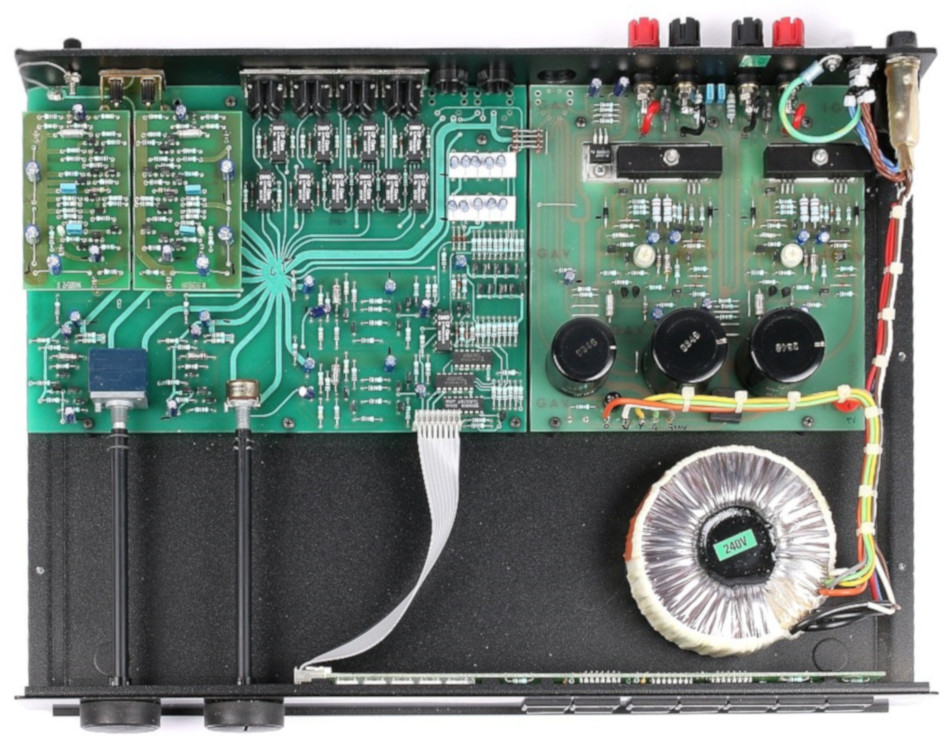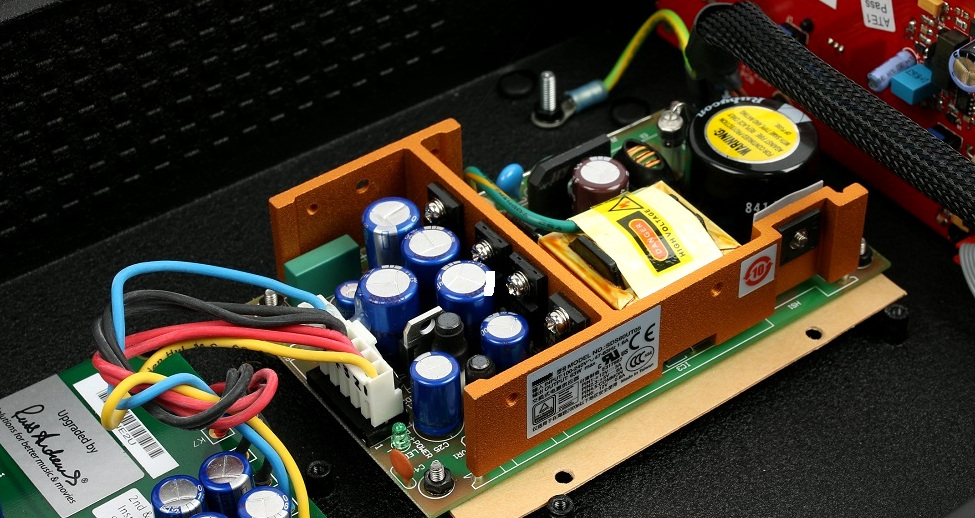A power supply is a device (built into the component, or housed separately) that allows us to operate an item of Hi-Fi hardware from our domestic mains wall socket. The mains is a high(ish) voltage, alternating current (AC) source. All Hi- Fi hardware circuitry runs on low voltage, direct current (DC) and the AC is converted into DC in the power supply. Traditionally, and in many cases still, the way this is accomplished by the power supply is by the use of a mains transformer to step down the high voltage to a usable lower voltage. A rectifier converts that into a DC voltage, a capacitor smooths its remnants of the 50Hz mains frequency, and a regulator cleans it up to deliver a perfect DC voltage to the amplifying circuits.
This is called a Linear power supply. Simple. Every item of Hi-Fi hardware needs a power supply!

A Naim integrated amplifier with linear power supply: the transformer can be seen bottom right; three large black smoothing capacitors are above it. The rectifiers and regulators are also on the right hand circuit board above the transformers, which is separate from most of the signal path which is on the left hand circuit board.
Naturally, there are problems. Linear supplies are assumed to be "stiff", meaning that the rated voltage and current remain the same when in use. The laws of physics dictate otherwise, unfortunately for circuit designers. Every power supply designer seems to believe that his power supply is as stiff as it needs to be and is able to supply the correct voltage output, whatever the mains voltage input.
How wrong they are! All the imperfections of the power supply end up in the amplifying circuit stages and all of the music being amplified runs back into the power supply; round and round and polluting the final signal output.
The pollution is a combination of mains noise and power supply noise modulated by the music signal fed back into it. Way back in the 1970s, I discovered startling evidence of this when I was examining the residual distortion of an amplifier on my test bench and found it was being modulated through the mains by a Hi-Fi system playing in the next door dem studio. I sat wondering where the change was coming from when it stopped the moment the music stopped in the dem room. A Eureka moment!
No wonder dems at Hi-Fi shows sounded disappointing. No wonder mains pollution has such a profound effect on the performance of a Hi-Fi system. No wonder that, over the years, I have put so much effort into finding ways to clean up the mains effectively without damaging the music further, and finding the very best sounding components for power supplies including ways to improve circuit's power supply rejection ratios.

Naim have long advocated the improvements to be gained from their range of sepereate, dedicated power supplies, such as this SuperCap DR
Working at the high end of the Hi-Fi spectrum, I found huge performance gains in circuit musicality and rhythm and timing gains by "over specifying" mains transformers, using Schottky rectifier diodes, slit foil smoothing capacitors and very well-designed regulators. The resulting power supplies were big, very heavy and expensive… but unbeatable!
Even standard linear PSUs are big, bulky and expensive to build, dominating the manufacturing costs of any unit of Hi-Fi hardware. They are also mains voltage dependent, meaning that the manufacturer must build them specifically for a country's mains voltage supply: 120V, 220V, 240V; more cost and manufacturing headaches in an increasingly international market.
Switched on
We said that the linear type of power supply is the traditional way to convert AC to DC, but there are other types. The most common of these is the Switch Mode Power Supply (SMPS) which is designed quite differently. There are many different types but in principle they convert the 50Hz mains frequency to a higher one (typically 50KHz) to feed the switching circuits, and smoothing and regulation circuits.
The resulting device uses much smaller and lighter components making it easier and cheaper to make - the weight saving cuts shipping costs and an SMPS typically works from 100V to 250V, so manufacturers only need to make one version to be compatible with worldwide mains voltages.
SMPSs have a further advantage of very low mains hum and vibration. SMPSs are not really new, but their use in Hi-Fi systems has become more widespread in recent years due to better, lower-noise designs, and outboard ‘wall-wart’ SMPSs are now common in smaller, low voltage, low current components like DACs, disc preamps, streamers and so on – see the box out below.
Quality is the key
The biggest disadvantage for our needs is the amount of EMI and RFI produced by the generation of the high frequencies of operation. The different designs emit different frequencies at different amounts, but they all do it. Careful choice of make and careful upgrading make all the difference in the resulting performance of Hi-Fi hardware powered by them.

Picture shows a Russ Andrews upgraded SMPS fitted into the Meridian G08 CD player - the use of high quality components, such as audio-grade Panasonic capacitors, is vital to performance.
So what do SMPSs have to offer the listener who demands musicality, rhythm and timing above mere Hi-Finess or the benefits of smaller size, lower weight and much lower cost?
The good news is that the best of them can deliver the joys of musicality, rhythm and timing. We have been selling upgraded versions of SMPSs for many years now (first as the PowerPaks and now as the Supplier DC).
"It is a common opinion in some quarters that all SMPSs are the work of the devil, so have no place in a high-end system. I can only guess that they have never conducted proper listening tests"
In many cases, though, the SMPS is not an option, because the component has to have an AC power supply and SMPS's only supply DC power to Hi-Fi components. But don't worry: in these cases, we have an alternative high-performance linear psu, the Supplier AC.
Battery power?
Battery power supplies would seem to be the answer to our problems with mains-powered supplies but, naturally, there are many unexpected drawbacks. Until very recently, rechargeable batteries have had very low storage capabilities, were limited in the available current they could supply, and had recharging issues. The development of Lithium-Ion batteries has delivered the really useful 18V high capacity rechargeable power tools that have now almost completely replaced mains power tools in the building industry.
Unfortunately for our needs, they have management circuits built into them that make them unsuitable for Hi-Fi powering uses. I have also found that batteries vary considerably in their ability to preserve the speed, rhythm and timing (and hence the musicality) of circuits powered by them. I would rather use linear and SMPSs in my own system... so far.
Other related Articles.
How to upgrade your power supply - practical advice on upgrading your existing 'outboard' psu.
























